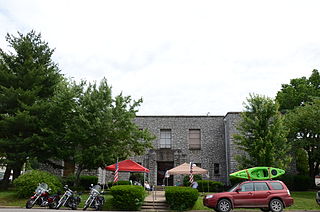
The Albert, formerly the Griswold Building, named after architect Albert Kahn, located at 1214 Griswold Street in Downtown Detroit, Michigan. It was listed on the National Register of Historic Places in 1980 and is part of the Capitol Park Historic District.

The El Tovar Apartments is an apartment building located at 320 East Grand Boulevard in Detroit, Michigan, in the East Grand Boulevard Historic District. It was listed on the National Register of Historic Places in 1991.

The Kingston Arms Apartments is an apartment building located at 296 East Grand Boulevard in Detroit, Michigan, in the East Grand Boulevard Historic District. It was listed on the National Register of Historic Places in 1999. The Kingston Arms, built in 1924, is a representative example of the rise of middle-class apartment buildings in pre-Depression era Detroit.

The Saint Paul Manor Apartments is an apartment building located at 356 East Grand Boulevard in Detroit, Michigan, in the East Grand Boulevard Historic District. It was listed on the National Register of Historic Places in 1999.

Saint Anthony's Hospital is a historic hospital building at 202 East Green Street in Morrilton, Arkansas. Built in 1935 to a design by A. N. McAninch, it is an Art Deco building, finished in brick and stone. It served as the local hospital until 1970, and is now a senior living facility. It is Morrilton's best example of Art Deco architecture. It has two splayed wings, with a central projecting entry pavilion.

The Pike County Courthouse is located at Courthouse Square in the center of Murfreesboro, Arkansas, United States. The two-story Art Deco structure was designed by the Texarkana firm of Witt, Seibert & Halsey, and built in 1931–32. It is the county's fourth courthouse, all of which were built at or near the location of this one. A near duplicate of the Sevier County Courthouse in DeQueen, it is the only major Art Deco structure in the county.

The Royal Edward Arms is an apartment building built in 1928 in the historic downtown of Fort William, part of the city of Thunder Bay, Ontario, Canada. It rises 8 storeys above the intersection of South May and George Streets.

The Rison Texaco Service Station is a historic automobile service station at 216 Main Street in Rison, Arkansas. It is a distinctive Art Deco structure built c. 1926. Since 1990 it has housed a timber company.

The Rison Cities Service Station is a historic automobile service station at Main and Magnolia Streets in Rison, Arkansas. It is a distinctive modest brick English Revival structure built in 1938. It has a cross-gable roof, in which there is a small oculus in each of the gables. The front facade has large plate glass windows flanking a central doorway. It was built and operated by the Arkansas Fuel and Oil Company, which operated it from 1938 to 1969 as the Cities Service Station. Since then it has been seen various commercial uses.

The Magnolia Commercial Historic District encompasses the historic heart of Magnolia, the county seat of Columbia County, Arkansas. It includes the courthouse square and most of the buildings which face it, as well as buildings along Calhoun and Jackson Streets. The centerpiece of the district is the square itself and the Columbia County Courthouse, a Renaissance Revival structure built in 1905 to a design by W. S. Hull. The square is lined with mostly brick-faced buildings built between about 1899 and 1910, and between 1938 and 1958, when the city experienced a second building boom. The oldest known surviving building, then as now housing a pharmacy, is located at 111 S. Court Square. One prominent building from the second building phase is the Cameo Theater Building, an Art Deco design built in 1948.

The Miller County Courthouse is a historic county courthouse at 400 Laurel Street in Texarkana, Arkansas, the county seat of Miller County. The four-story Art Deco building was designed by Eugene C. Seibert and built in 1939 with funding from the Works Progress Administration. It is the second courthouse built for the county, and is an excellent local example of the WPA Moderne style of Art Deco architecture. The lower floors of the building are occupied by county offices and court facilities, and the fourth floor houses the county jail.

The Arkansas County Courthouse for the Southern District is located at Courthouse Square in the center of De Witt, Arkansas, the seat for the southern county of Arkansas County. It is a three-story brick building with Art Deco styling, designed by Little Rock architect H. Ray Burks and built in 1931. It is one of the finest examples of Art Deco architecture in the state. It is built in the shape of an H, with vault additions made in 1971 the only asymmetrical element. Its main entry is a simple double-leaf entry with transom window, topped by a concrete panel with floral design. This is topped by a pair of large windows, with a concrete panel with signage and clock above and a raised parapet at the top.

The Pocahontas Post Office is located at 109 Van Bibber Street in downtown Pocahontas, Arkansas. It is a single-story square brick building with a flat roof highlighted by a concrete cornice. It was built in 1936-37 with funding from the Works Progress Administration, and is a fine local example of restrained Art Deco architecture. Its main lobby houses a mural funded by the Section of Fine Arts, drawn by H. Louis Freund, entitled Early Days of Pocahontas.

The Price Produce and Service Station is a collection of three related commercial buildings at 413, 415, and 417 East Emma Avenue in Springdale, Arkansas. It includes one building that hosted an automotive filling station and produce shop, a second that traditionally housed a barbershop, and a third structure, originally open but now enclosed and housing a residence, that was used as an automobile service area. The buildings were all built in 1934, and are united by common Art Deco styling, most prominently lancet-topped pilasters that rise above the height of their roofs. The complex is regarded as a fine local example of vernacular Art Deco, and as a surviving element of the automotive culture of the 1930s.

The Newton County Courthouse is located at Courthouse Square in the center of Jasper, the county seat of Newton County, Arkansas. It is a two-story masonry structure, constructed out of concrete and limestone, with restrained Art Deco styling. The building has an H shape, with a center section joining flanking projecting wings. The entrance is at the center, with "Newton County" inscribed in a panel above it, with stylized Art Deco elements. It was built in 1939 with funding from the Works Progress Administration.

The National Guard Armory-Pine Bluff is a former National Guard armory at 623 West 2nd Avenue in Pine Bluff, Arkansas. It is a two-story masonry structure, built out of concrete and buff brick with Art Deco styling, included a castellated parapet. It was built in 1931, and was the first state-owned militia building in Jefferson County. It served as a state armory until 1974, housing the 39th Tank Company, and now houses vocational classrooms.

The Wallace Building is a nine-story commercial skyscraper at 101-11 Main Street in downtown Little Rock, Arkansas. It was built in 1928 to a design by Little Rock architect George R. Mann, and is an excellent local example of early Art Deco architecture. It was built by George Washington Donaghey, a former Governor of Arkansas; Mann and Donaghey had previously worked together on the Arkansas State Capitol, with disputes over its construction propelling Donaghey into politics and the governor's seat. This building is named after his wife's maiden name.

The Clarksville National Guard Armory is a historic former National Guard Armory at 309 College Street in Clarksville, Arkansas. It is a two-story building, finished in brick with restrained Art Deco styling. Its main facade is 10 bays wide, with a projecting section at the center housing two bays on the upper floor, and a double door entrance on the first. The entrance is set in a stepped recess, and it and the windows above are flanked by brick pilasters at the corner of the projection. The building was built in 1930, and served the Arkansas National Guard as a training and storage facility until 1980, after which ownership was turned over to the city.

The YMCA Building is a historic building located in Waterloo, Iowa, United States. The local YMCA was established in 1868, three months after the city was incorporated. Its first permanent building was built at this location in 1893. As membership expanded they eventually out grew the building, and it was torn down in 1930. The present building was designed by local architect Mortimer Cleveland and his associate D.B. Toenjes. The general contractor was H.A. Maine Construction. The three-story brick structure features decorative elements from the Art Deco mode. The first level has housed commercial firms in the storefronts. An addition was built onto the west side of the building in 1959 to house adult activities. The local YMCA built a new facility and moved from here in 1982. The following year the building was listed on the National Register of Historic Places. It has been converted into an office building.

The Union Park Hotel is a historic hotel building located at 1519-1521 W. Warren Boulevard in Chicago, Illinois. The building was built in 1929-30 as an apartment hotel, a common type of housing for Chicago laborers in the 1920s. The hotel's Art Deco design reflects the national popularity of the style in the 1920s. The building's piers give it a vertical emphasis common to Art Deco works, and its decorative elements reflect the style's geometric focus. The colorful brick and terra cotta facade of the building is also characteristic of Art Deco buildings of the late 1920s, though color is seldom used extensively in Chicago's other Art Deco buildings.
























